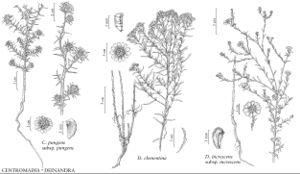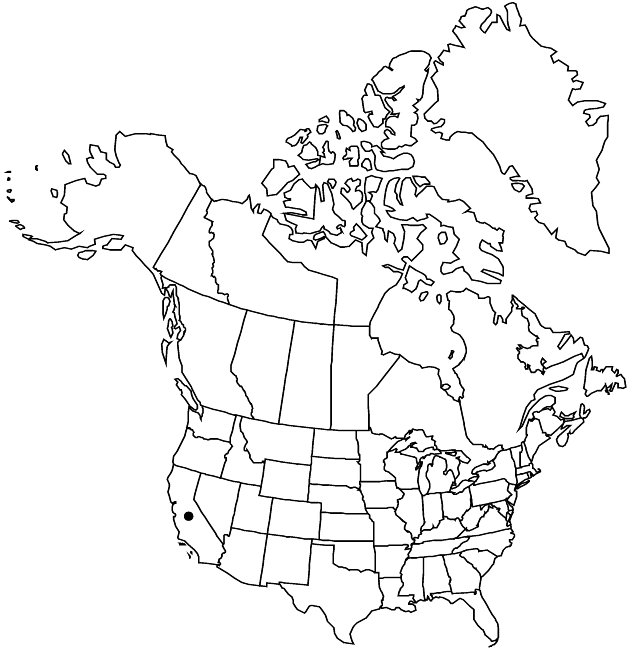Difference between revisions of "Deinandra clementina"
Novon 9: 468. 1999.
FNA>Volume Importer |
imported>Volume Importer |
||
| (6 intermediate revisions by 2 users not shown) | |||
| Line 7: | Line 7: | ||
|year=1999 | |year=1999 | ||
}} | }} | ||
| − | |basionyms={{Treatment/ID/ | + | |special_status={{Treatment/ID/Special_status |
| + | |code=F | ||
| + | |label=Illustrated | ||
| + | }}{{Treatment/ID/Special_status | ||
| + | |code=E | ||
| + | |label=Endemic | ||
| + | }}{{Treatment/ID/Special_status | ||
| + | |code=C | ||
| + | |label=Conservation concern | ||
| + | }} | ||
| + | |basionyms={{Treatment/ID/Basionym | ||
|name=Hemizonia clementina | |name=Hemizonia clementina | ||
|authority=Brandegee | |authority=Brandegee | ||
| + | |rank=species | ||
| + | |publication_title=Erythea | ||
| + | |publication_place=7: 70. 1899 | ||
}} | }} | ||
|synonyms= | |synonyms= | ||
| Line 27: | Line 40: | ||
|distribution=Calif. | |distribution=Calif. | ||
|discussion=<p>Of conservation concern.</p><!-- | |discussion=<p>Of conservation concern.</p><!-- | ||
| − | --><p>Deinandra clementina is known only from six of the Channel Islands (Anacapa, San Clemente, San Nicolas, Santa Barbara, Santa Cruz, and Santa Catalina).</p> | + | --><p><i>Deinandra clementina</i> is known only from six of the Channel Islands (Anacapa, San Clemente, San Nicolas, Santa Barbara, Santa Cruz, and Santa Catalina).</p> |
|tables= | |tables= | ||
|references= | |references= | ||
| Line 36: | Line 49: | ||
-->{{#Taxon: | -->{{#Taxon: | ||
name=Deinandra clementina | name=Deinandra clementina | ||
| − | |||
|authority=(Brandegee) B. G. Baldwin | |authority=(Brandegee) B. G. Baldwin | ||
|rank=species | |rank=species | ||
| Line 50: | Line 62: | ||
|publication title=Novon | |publication title=Novon | ||
|publication year=1999 | |publication year=1999 | ||
| − | |special status= | + | |special status=Illustrated;Endemic;Conservation concern |
| − | |source xml=https:// | + | |source xml=https://bitbucket.org/aafc-mbb/fna-data-curation/src/2e0870ddd59836b60bcf96646a41e87ea5a5943a/coarse_grained_fna_xml/V19-20-21/V21_691.xml |
|tribe=Asteraceae tribe Heliantheae | |tribe=Asteraceae tribe Heliantheae | ||
|subtribe=Asteraceae (tribe Heliantheae) subtribe Madiinae | |subtribe=Asteraceae (tribe Heliantheae) subtribe Madiinae | ||
Latest revision as of 20:13, 5 November 2020
Subshrubs or shrubs, 15–80 cm. Stems ± solid (floccose in some leaf axils). Leaves: proximal blades toothed or entire, faces pubescent to somewhat canescent, ± hirsute, strigose, or scabrous, often stipitate-glandular. Heads usually in crowded, corymbiform or paniculiform arrays. Bracts subtending heads usually overlapping proximal 0–1/2+ of each involucre. Phyllaries ± evenly stipitate-glandular (sometimes sparsely), including margins and apices, often with non-glandular, pustule-based or non-pustule-based hairs as well. Paleae in 2 series (1 between ray and disc florets, 1 between outermost and adjacent disc florets). Ray florets (11–)13(–20); laminae deep yellow, 4.5–7 mm. Disc florets 18–30, all or mostly functionally staminate; anthers reddish to dark purple. Pappi of 7–10(–15) lance-linear, fimbriate scales 1–3 mm. 2n = 24.
Phenology: Flowering Mar–Dec.
Habitat: Grassy areas, coastal scrub, semi-barren sites, edges of salt marshes, on terraces, slopes, and ridges, often in rocky or clayey soils
Elevation: 0–200 m
Discussion
Of conservation concern.
Deinandra clementina is known only from six of the Channel Islands (Anacapa, San Clemente, San Nicolas, Santa Barbara, Santa Cruz, and Santa Catalina).
Selected References
None.

